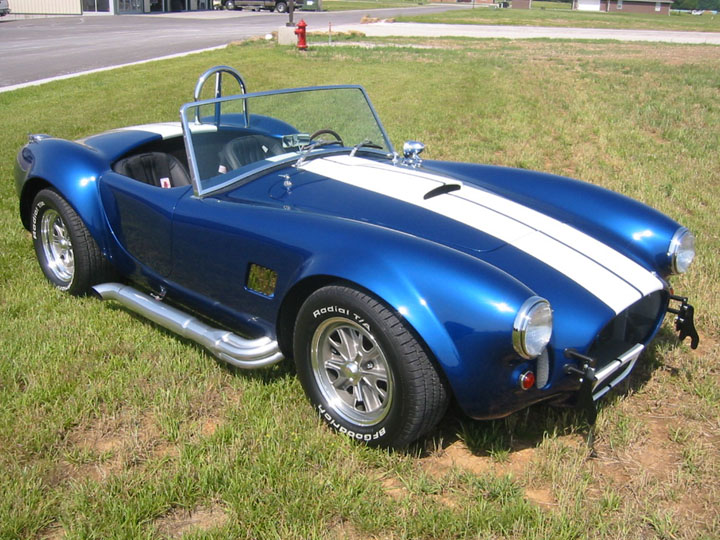Classic Cars With Bob Gelber

For the record, I’ve never been a fan of replica or kit cars. That being said, I will admit that some of them are absolutely sensational copies of the real thing. The kit car business has certainly come a long way since those awful looking “Gazelle” and “Mi-Gi” faux Mercedes SSK and MG fiberglass bodies that were mounted upon early air-cooled Volkswagen chassis. The two replica cars that currently are impressive to me are the various Shelby Cobras and Porsche Speedsters that seem to dominate the home car builder’s scene.
Kit car manufacturing companies like Factory Five and Superperformance make absolutely superb Cobra kits. The Beck Company makes a Porsche Speedster kit that is so accurate only the thickness of the fiberglass body (not like the original one’s aluminum), gives it away as being a fake. The best replica car is the one that looks absolutely like the real thing in every detail, which is harder to do than one one might think. The beauty of the Cobra and Porsche kits is the fact that virtually every single small detail of the car can be bought in the marketplace. Those amazing looking knock-off Halabrand magnesium wheels for the original Cobra are now reproduced for the replica Cobra in much less expensive aluminum. Every truly correct Cobra replica is shod with them. Thankfully, the Porsche used inexpensive common Volkswagen stock wheels. The dashboard gauges for the Cobra and Speedster are still all available, as well as many other parts. Accuracy is what makes these cars truly original looking. [expand]
For the record, you can even open the hood of both these cars and see what looks like the correct engine. Ford V-8s are common enough to get for the Cobra, and any competent mechanic can dress up an old air-cooled VW engine to look exactly like a Porsche air-cooled powerhouse. (I use that expression”powerhouse” loosely, because all the old Speedsters had way under 100 horsepower). Also, part of the “look and build” quality formula is how well the car is built, put together and painted by the homebuilder.
America builds some impressive kit cars, but the kings of kit, or replica-car builders are foreign. Lynx Manufacturing of England not only makes replacement body panels of aluminum for vintage Jaguar “C” and “D” type race cars, but also actually offers entire replica “C” and “D” type Jaguar race cars for sale. Arguably, these are two of the most beautiful race cars ever made, and probably the most famous. Real ones cost way over $1 million each, but you can purchase a handmade factory built aluminum Lynx replica for a little over $100,000. Unless you are a true Jaguar expert you certainly would have a hard time discerning if it’s a replica. Buy one of these fantastic looking vintage racing machines, and with a smile on your face put on your fake Rolex and drive this Lynx Jag to Pebble Beach Concours D’elegance. You’ll probably fool all those snooty judges and win an award. Take that, Ralph Lauren and Jay Leno!
The best replica I’ve ever been in is a Ford GT-40 built by a company in, of all places, South Africa. It was so faithful to the original; I would swear that it was original. The only thing that could have possibly given it away was that it was too well built to be an original. If you know anything about vintage race cars you know that they were not that well built, but this GT-40 was perfect in every detail. They were built to win races, period. I’m very familiar with the GT-40, and to this day, I don’t know how they did it. It was like a truly masterful copy of an original Rembrandt.
Speaking of fine art, the Italians, like the British, are masters of “rolling” aluminum body panels and have produced some really fine copies of valuable Ferrari race cars. Many of them are powered by Ferrari V-12 engines taken from once old, not popular low priced Ferrari GTEs, 330s and the like. Years ago, some of these cars were put on the market as originals. Once discovered, lawsuits transpired. If you are lucky enough to make offers on high-end Italian automotive art, please check to make sure of their originality. Fake valuable collector cars have been discovered in museums.
One other warning about replica cars: Unlike the real item, they don’t go up in value, in fact they either stay the same, like some good aluminum-bodied Lynx-level replicas, or go down in price, like the more common fiberglass wonders. Also, the average person doesn’t like fakes, whether it is a car…or another human being.
Bob Gelber is an automotive journalist who has lived in the Hamptons for over 35 years. He can often be seen on television talking about his favorite subject, automobiles. bobgelber@aol.com









